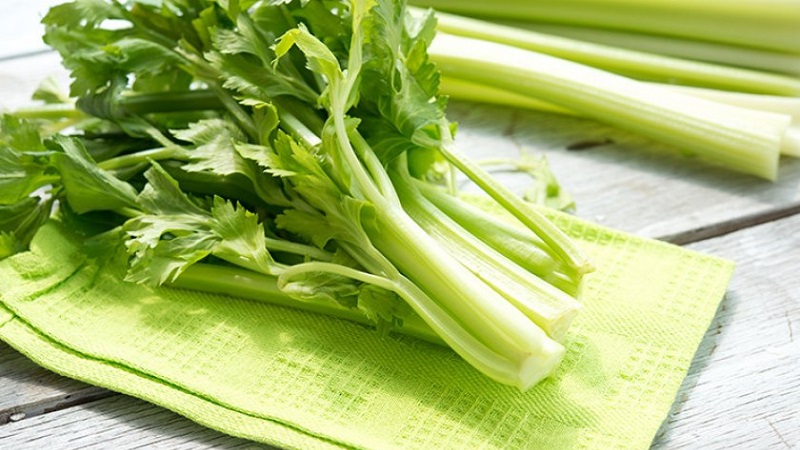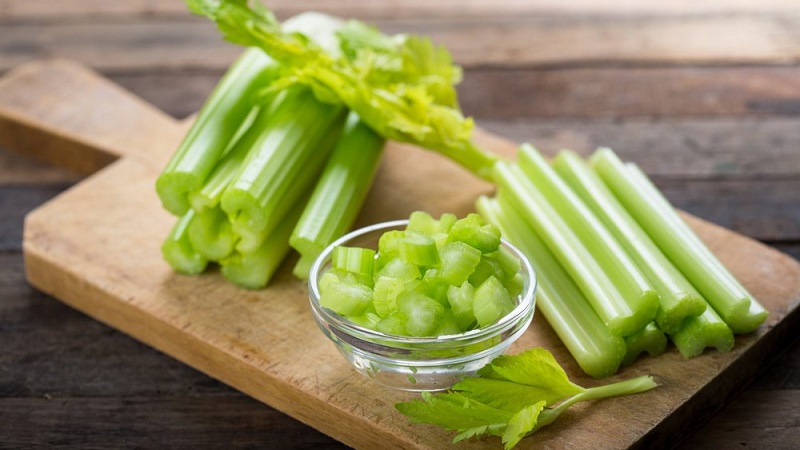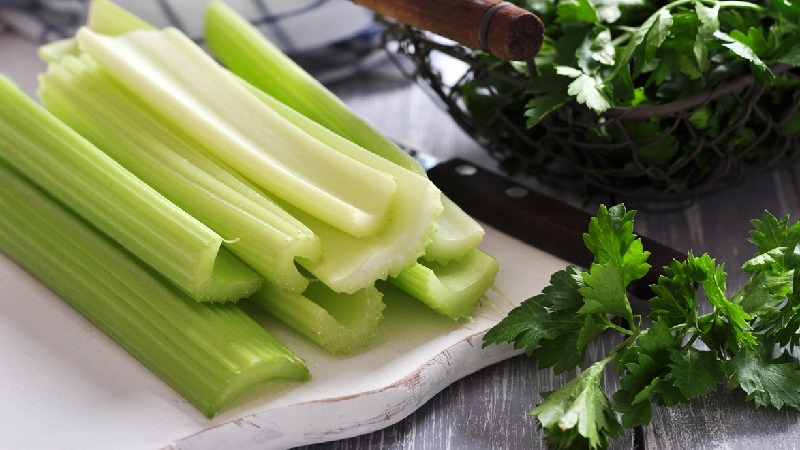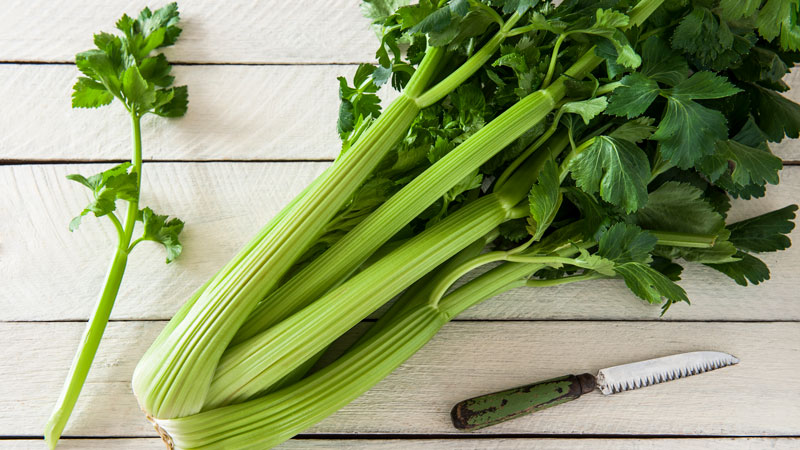The benefits and harms of celery for human health
Celery - one of the most popular products in dietetics. A low-calorie vegetable with a rich chemical composition normalizes the functioning of the digestive, cardiovascular, nervous, genitourinary and immune systems.
We will talk about the benefits and dangers of celery, use in folk medicine, home cosmetology and cooking further.
The content of the article
Composition and properties

Celery is a biennial or perennial herb of the Umbrella family... One of the many species, cultivated celery (fragrant, aromatic), is cultivated as a vegetable. The plant brought to us from Europe during the era of Catherine the Great has been used for over 200 years not only as a green spice, but also as a healing dietary product.
Celery is full of nutrients and vitamins. For 100 g of greens, there are:
- 3.3-4.3 g dietary fiber... Fiber cleanses the body of toxins, removes fluid, heavy metal salts.
- 4500 mcg of beta-carotene. Supports the heart, blood vessels, organs of vision, has antioxidant properties.
- 283 mcg Lutein and Zeaxanthin. They are useful for the organs of vision, resist cataracts and retinal dystrophy, eliminate inflammatory processes in the body.
- 29.3 mcg vitamin K. Increases the elasticity of the walls of blood vessels, normalizes digestion.
- 0.5 mg vitamin E... Slows down aging, protects the heart muscle, stimulates the endocrine system, gonads.
- 38 mg vitamin C... Natural immunostimulant and antioxidant strengthens bone, connective tissue, participates in collagen production, affects metabolism.
- 0.02 mg thiamine (B1). Stabilizes metabolic processes.
- 0.25-0.42 mg riboflavin (B2). Protects the retina from ultraviolet radiation, participates in the synthesis of hormones and erythrocytes.
- 0.25 mg of pantothenic acid (B5). Participates in metabolic processes, affects the peristalsis of the digestive system.
- 0.08 pyridoxine (B6). Participant in protein metabolism. It is good for blood, increases hemoglobin, normalizes the nervous system, prevents muscle cramps and spasms.
- 36 mcg folic acid (B9). Regulates hematopoiesis, cell division.
- 0.4 mg niacin (PP). Affects the nervous system, gastrointestinal tract, improves the condition of the skin and mucous membranes, supports the heart.
- 6.1 mg choline (B4). Natural nootropic, antidepressant. Protects cell membranes from destruction, reduces the level of harmful cholesterol in the blood.
The vegetable has a rich mineral composition.
Reference. Macronutrients maintain the condition of the skin, prevent brittle hair and nails, increase the permeability of blood vessels, strengthen their walls and prevent the formation of blood clots and plaques.
Macronutrients (per 100 g of product):
- 430 mg potassium;
- 72 mg calcium;
- 50 mg magnesium;
- 200 mg sodium;
- 80 mg sulfur;
- 77 mg phosphorus;
- 2.9 mg silicon;
- 27 mg chlorine.
Trace elements are the builders of cells. They support the endocrine system and are important for joints and connective tissue.
100 g of greens contains:
- 1.3-6.3 mg iron;
- 200 mcg manganese;
- 103 mcg copper;
- 153 mcg rubidium;
- 72.2 mcg boron;
- 24.2 mcg vanadium.
In small quantities, the vegetable contains selenium, iodine, lithium, chromium, zinc.
All parts of the plant are used in cooking. Roots rich in vitamin K (34% of the daily value), rubidium (163%), silicon (97%), boron (60%), vanadium (28%).
Essential acids are responsible for the regulation of hormones and the work of the central nervous system (in mg per 100 g):
- 70–80 - valine, leucine, lysine;
- 40-50 - isoleucine, threonine, phenylalanine;
- 10–20 - histidine, methionine, tryptophan.
Replaceable acids normalize protein and lipid metabolism, are useful for muscle tissue, and participate in the conduction of nerve impulses.
100 g of greens contains (in mg):
- 380 - glutamic acid;
- 206 - aspartic acid;
- 67 - alanine;
- 40 - glycine, proline, arginine;
- 20 - tyrosine.

The nutritional value
The calorie content of celery per 100 grams is only 13 kcal. The plant is 95% water.
The vegetable contains no cholesterol and alcohol. 100 g of greens contains the daily norm of galactose.
BZHU ratio:
- proteins - 1.5 g;
- fats - 0.3 g;
- carbohydrates - 3.9 g
Root vegetables contain more carbohydrates (9.6 g). They contain up to 6% sugars, including glucose and fructose.
Harm and benefits to the body
Celery is a waste-free vegetable: leaves, stems and roots are used for medicinal purposes and in cooking.
The plant is used for various diseases and for their prevention:
- the use of fresh greens, in salads with carrots, relieves of nervous disorders, calms, relieves anxiety and normalizes sleep;
- freshly squeezed juice is useful for chronic inflammation of the bladder;
- leaves and stems are a good prophylactic agent for urolithiasis;
- lotions and compresses are made from the gruel of crushed green mass for purulent inflammation of the skin, allergic rash;
- celery as a natural antiseptic and antioxidant gently cleanses the body of toxins, salts, protects against viruses and infections;
- juice is useful for the digestive system, relieves the condition of peptic ulcer, gastric and intestinal disorders;
- the vegetable supports the heart and vascular system, affects the general blood flow and the process of hematopoiesis (normalizes the level of hemoglobin and cholesterol);
- the root lowers blood sugar levels, therefore it is allowed for people suffering from diabetes;
- celery is useful for hypertensive patients - it slightly, but lowers blood pressure;
- due to its rich mineral composition, the vegetable prevents fatty liver, normalizes carbohydrate and lipid metabolism.
Only the immeasurable consumption of celery causes harm. For people suffering from chronic diseases of the kidneys, liver, stomach, women during lactation and pregnancy, it is better to reduce the amount of vegetables in the diet.
Beneficial features
Celery has specific properties that have a beneficial effect on the body of both adults and children.
For men
The vitamin composition of the plant stimulates the male reproductive function.
The root and petioles contain phytoestrogens and phytoandrogens (natural hormones). They normalize testosterone production.
To enhance potency, the stems and root crops are recommended to be consumed regularly for 1-2 months.
Interesting! According to legend, celery was part of the "elixir of love" by Tristan and Isolde. Natural aphrodisiac increases sex drive and enhances sexual activity.
The plant improves the general blood flow, removes harmful substances, eliminates inflammation, directly affects the prostate gland, resists congestion in the pelvic area and pathologies of the genitourinary system.

For women
Fiber gently cleanses the body, normalizes bowel function.
The vegetable has a beneficial effect on the general condition of a woman during menopause and during menstruation. Relieves irritability, pain syndromes, helps with hormonal changes in the body.
Tocopherol - the source of youth - resists aging at the cellular level, rejuvenates the body. Minerals and vitamins eliminate hair dullness and brittleness, strengthen nails.
Regular consumption of a vegetable in food gives a charge of vivacity, increases the tone of the body and affects libido.
For a pregnant woman, cocktails, salads, smoothies with celery will become a barrier to viral infections and colds.At the same time, the vegetable is dangerous, especially in the last weeks of pregnancy (it can provoke premature birth). Therefore, consult a doctor before use.
The seeds of the plant are used in folk medicine to treat bladder infections, cystitis.
For kids
Already from 8-9 months of age, when vegetables are gradually introduced into the child's diet, neonatologists and pediatricians recommend including raw and thermally processed celery in the diet.
Helpful! 1 tsp freshly squeezed juice before bedtime will calm the baby, will act as a sleeping pill.
The juice of the plant is hypoallergenic, it is used for diathesis, urticaria and allergic rash externally (do compresses, rubbing, lotions) and inside. An ointment based on chopped greens perfectly heals cuts, shallow burns and abrasions.
In adolescence, when acne, inflammation, peeling appear on the skin, it is recommended to use fresh celery. With a hormonal surge during growing up, the vegetable is included in the diet to reduce body weight with obesity and overweight.
The plant stimulates brain activity, increases efficiency and maintains overall tone.

Consumption rates
The daily intake of greens (including celery) is 50–100 g for an adult. For children, the portion is divided in half.
If there are other herbs in the diet (basil, parsley, dill), it is enough to eat 1 branch or stem of the plant per day.
In what form is
Greens and petioles are combined with peppers, tomatoes, cucumbers and other colorful vegetables in salads, fish and meat dishes.
Grated root suits sweet and sour apples. This salad is seasoned with honey and lemon juice.
For fresh and cocktail, mix celery juice with vegetables and fruits. Especially useful and nutritious are mixtures with banana, lime, cabbage and beets.
Freshly squeezed juice is added as a dressing to salads, okroshka, cold soups.
Application
Fragrant celery with a unique aroma and piquant taste is not just a table decoration, a dietary product, but also a natural healer.
In cooking
To diversify and balance meals, nutritionists suggest several ways to use celery in food:
- prepare cocktails, smoothies, fresh juices with vegetable pulp;
- seasoned with herbs first courses, cold soups;
- fresh celery is used in prefabricated vegetable salads;
- side dishes and sauces are prepared from it, baked, boiled, made stews with peppers, potatoes, tomatoes;
- used for homemade preparations as a seasoning for tomatoes, adjika (as a spice celery gives a special taste to cucumbers and tomatoes when salted quickly);
- a dietary puree is prepared from the boiled root with milk, bread crumb and butter;
- lovers of sweets add the vegetable to desserts, salads with fruits and apples, which are seasoned with yogurt or sour cream.
In folk medicine

Adherents of vegetable medicine give some useful tips:
- for the healing effect, celery is consumed only raw or in the form of freshly squeezed juice;
- chop the vegetable, preferably by hand, using only a plastic grater;
- "Medicine" is taken before meals, 20-25 minutes;
- rest for 5-7 minutes is recommended after administration;
- a decoction of ground root (1 tbsp. l. per 250 ml of water) restores the nervous system, normalizes sleep;
- a mixture of celery and carrot juice in equal proportions will help with vitamin deficiency and loss of strength;
- with inflammation of the bladder and urolithiasis, drink juice (1 tsp. 3-4 times a day);
- compresses, lotions, rubbing, masks cleanse the skin from abscesses, inflammations and irritations, are effective for burns and wounds;
- dandelion, celery and nettle juice, taken in equal parts, purifies the blood;
- for jade, constipation, use a tincture of roots and leaves, steamed in a water bath;
- 2 tbsp. l. grated root, poured in 200 ml of water - a medicine against allergies.
Alternative medicine is only supportive therapy.For the treatment of acute and chronic diseases, they turn to doctors.
In cosmetology
At home, mashed celery gruel is used as a cleansing and nourishing mask for the face and décolleté... The product whitens age spots, eliminates oily sheen.
Frozen juice cubes tone and rejuvenate the skin, smooth crow's feet.
A decoction or infusion of leaves is a useful conditioner for hair, which makes it manageable and shiny.
Slimming
Leaves and petioles are low in calories. They are consumed without fear of exceeding the daily calorie intake. In terms of energy functions, a vegetable replaces many fruits and berries.
Dietary fiber gently cleanses the body, removes salts, toxins, excess fluid. Morning edema disappears, lightness and mobility appear, weight gradually decreases.
Reference. Celery "dissolves" visceral (deep) fat. This not only positively affects the work of all internal organs, but also noticeably affects the appearance (centimeters at the waist and abdomen decrease).
Who is contraindicated
The plant has no direct contraindications, no negative reactions have been recorded with proper use.
With care, the vegetable is included in the diet:
- with individual intolerance, especially when the body "got acquainted" with the plant late and does not accept a new product (it is introduced gradually);
- with natural feeding, they consume fresh herbs 2-3 months after childbirth, as there is a risk of gas and a disorder of the child's still not strong digestive system;
- during pregnancy, use depends on the well-being of the expectant mother, they first consult with a doctor;
- in old age with frequent gastrointestinal disorders and exacerbation of chronic diseases, consult a specialist before use.
Reviews
According to experts and lovers of spicy greens, celery not only diversifies the diet, but also makes it balanced.
Nadezhda Volodarskaya, endocrinologist: «The vegetable is good for men's health: phytoandrogens not only stimulate testosterone synthesis, but also partially replace it ”.
Anthony William, food consultant, popular author of books on healthy eating: “Every morning should start with a glass of freshly made celery juice. This is an easy way to always be in great shape and forget about those extra pounds forever. "
Conclusion
Celery is one of the most affordable and healthy vegetables. With constant overload, excessive employment, unfavorable environmental conditions, such an energy stabilizer will support the body, saturate with vitamins and minerals, and protect against diseases.